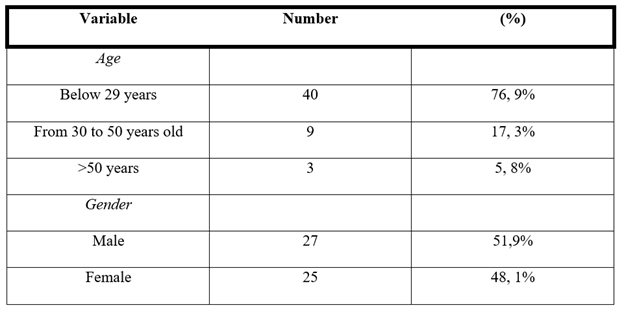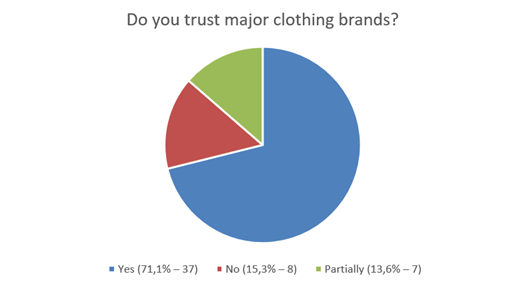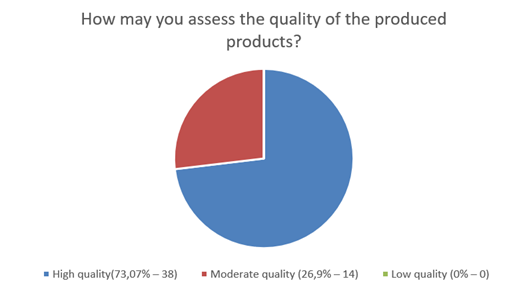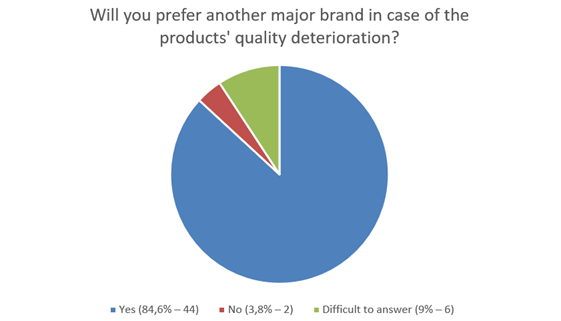Introduction
The market competition of the modern era consists of various factors influencing the consumer. The success of a product’s market sales is defined not only by its quality, functionality, or uniqueness; a high-quality promotion campaign or brand’s positive reputation often overweight the characteristics of a given product. Such an aspect as a brand’s image has a direct impact on a customer’s satisfaction and allows a company to establish a durable relationship with a buyer (Taqi, & Ghulam, 2021). Since this strategy has proven to be highly effective, most modern companies attempt to build a positive and reliable brand image. As a result, companies cannot compete only on the basis of the physical qualities of the goods they sell (Taqi, & Ghulam, 2021). Moreover, a firm with a proper image is often highly trusted by the customers; hence, the given company has to spend less money on promoting a specific product (Taqi, & Ghulam, 2021). Therefore, modern companies attempt to use customers’ loyalty and trust in a brand’s image as one of the primary means of a product’s successful sale.
The approach outlined above often results in a customer’s complete trust in a given company’s goods quality, which a firm may abuse, providing a buyer with low-quality goods. To increase the profit level, a company may focus on low-quality products sales (Falahat et al., 2018). Even though the customers may be aware of a given goods’ quality, proper advertising can increase their willingness to pay for a certain product (Falahat et al., 2018). However, a high-quality advertisement usually defines customers’ expectations towards a particular product (Chenavaz, Jasimuddin, 2017). Including the fact that customers’ satisfaction is the basis of a brand’s positive image, sooner or later, the lowering of the goods’ quality will be noticed (Taqi, 2020). Due to the fact that modern customer is provided with a wide choice of products options, his or her decisions have become more selective, thus, more attentive to the goods’ quality (Dong, Gleim, 2018). Therefore, a high-brand company’s ability to avoid consequences for selling low-quality goods depends on multiple aspects.
Customer’s Quality Expectations and Factors Influencing It
A customer’s unfulfilled expectations regarding the quality of the product may have a tangible negative impact on a seller’s reputation. The advertisement or a general image of the brand form a specific level of a customer’s demand for product quality (Hanifati, Salehudin, 2021). Although this is “a subjective concept that exists in the minds of consumers”, it affects customers’ decision to buy a particular product (Hanifati, Salehudin, 2021, p. 171). Since the customer has a certain level of expectations while purchasing a specific product, the discrepancy between the quality of the product and his or her expectations may result in an adverse reaction. It is crucial to mention that a seller directly impacts customers’ quality expectations (Chenavaz, Jasimuddin, 2017). One of the factors which impact a buyer’s expectations is the level of advertisement quality (Chenavaz, Jasimuddin, 2017). Thus, a product with an expensive and high-quality promoting campaign often creates an elevated level of customer demand for its quality (Chenavaz, Jasimuddin, 2017). Unfortunately, if a buyer’s expectations are not met in a post-purchase period, it may lead to a breach of trust between a customer and a company.
It is crucial to understand that a brand maintains its high status due to a proper image, and, more importantly, due to a credible reputation. In its turn, the company’s reputation affects the customer’s expectations regarding product quality (Dong, Gleim, 2018). Nowadays, customers often imply so-called ‘brand association’ in order to choose a fitting product (Falahat et al., 2018). This means that a particular brand is often associated with a specific quality, price, or product category (Falahat et al., 2018). Thus, a product’s quality is the basis of a high-brand company’s credible reputation; the production and distribution of a substandard product may have a negative impact on the brand’s image.
Customer’s Satisfaction and Its Influence on a Company’s Image
A customer’s satisfaction plays a key role in a product’s sales rates and affects the given company’s reputation; the basis of this satisfaction is the quality of received goods. According to Ibrahim Taqi, a buyer’s satisfaction is an essential factor in building a “sustainable relationship with a brand” (2020, p. 104). A sufficient level of satisfaction often results in customers’ loyalty to a specific brand; since they are used to a certain level of quality, they know what to expect from a seller (Taqi, & Ghulam, 2021). Loyalty to the brand allows a firm to grow its influence and increase its market position. Moreover, loyal customers often enlarge the client base by recommending the specific brand to another potential buyer (Taqi, & Ghulam, 2021). However, brand loyalty is a clear result of a customer’s fulfilled expectations and can only be ensured by a proper quality of goods. Since brand loyalty is a crucial factor of a given company’s success, the lowering of goods’ quality may result in a decrease in loyal customers’ numbers due to their unfulfilled expectations.
Monopoly and Goods’ Quality
Although it may seem that modern companies have no ability to sell substandard goods without negative consequences, the situation will differ in the case of a monopolistic company. Since the monopolistic company will most likely not encounter the same competitive level as a regular company under healthy free market conditions, it possesses greater freedom of action (Yuldasheva, Murodov, Suvonquolov, 2020). Thus, the monopoly has the ability to artificially increase the product’s price in order to maximize profit. At the same time, the monopolists can distribute the products of poorer quality to cut short the production expenses (Yuldasheva, Murodov, Suvonquolov, 2020). What is most important is that the customer cannot choose between several companies while deciding to buy a specific product. Thus, if a company holds a monopoly over the sales of a given product, it has the ability to get away with selling substandard goods.
Aims of the Study
The main aim of this study is to assess the current situation concerning the quality of goods in the modern free markets. There is a need to consider all possible factors influencing both buyer and seller’s decisions. Moreover, the changes in the levels of brand loyalty must be assessed as well. It is essential to list the secondary aims of this study; due to various monopolistic companies’ existence, it is essential to assess their possibilities regarding the discussed matter. In addition, there is a need to assess the level of a regular customer’s awareness and its role as one the quality-regulating factors.
Hypothesis
As a result of the examination of the materials on the given topic, the following hypotheses were formulated:
- Under the conditions of modern free markets major companies are not able to sell substandard goods without consequences;
- The fulfilment of a customer’s quality expectations is a defining factor of a successful goods’ distribution;
- Most modern major companies cannot risk their credible reputation and provide their customers with low-quality products;
- Monopolistic company will most likely get away with selling substandard goods;
- The customers have become more aware of the products’ quality.
Objectives
In order to prove the stated hypotheses, there is a need to complete the following objectives:
- To study the quality of goods distributed by various high-brand companies;
- To evaluate current rates of brand loyalty among the customers;
- To examine existing monopolistic companies and the quality of their produced products;
- To analyze the current state of an average customer’s awareness;
- To assess the link between the quality of goods and customer retention using the analysis of data collected among the citizens of Ghana.
Literature Review
Customer Retention
Due to the current free-market conditions of the aggressive competition among the companies, the companies have a constant need to improve and modernize their approach to customers in a timely manner. In order to sustain a high level of profit, the companies focus their attention on the retention of customers (Mahmoud, 2018). According to Hanaysha J.R. and Ahmed A., “focusing on customer retention has become very important for improving organizational performance and competitiveness” (2017, p. 1). As per Alkitbi et al., a strong link between the degree of customer’s retention and the amount of the company’s profit has been detected (2021). In addition, such parameters as a quality of a product is a defining factor in customer retention (Hanaysha, & Ahmed, 2017). Their commitment to the brand is based on their fulfilled expectations regarding a product’s quality coupled with the quality itself (Utami, & Kesuma, 2021). Thus, to increase the rates of customer retention, companies often attempt to produce their products according to specific quality standards.
Corporate Image
The reputation of a company on the market is sustained due to a company’s ability to match a particular image; this aspect directly influences the company’s profit and concerns the quality of the produced goods. The customer’s satisfaction level and their expectations towards a specific commodity’s quality level are formed by their perception of one particular brand (Anisimova, Weiss, & Mavondo, 2019). For instance, if the given firm is known for selling low-priced substandard goods, and buyers expect a low level of quality, then the situation will not appear problematic for the given company (Taqi, & Ghulam, 2021). Since a certain set of a produced commodity’s properties is a part of a brand’s corporate image, the goods’ quality’s variance may negatively impact a firm’s reputation on the market (Taqi, & Ghulam, 2021). Therefore, a particular brand image requires it to sustain a specific quality level in order to retain loyal customers.
In the last several decades, the tendency among customers to expect a particular set of a product’s properties according to their perception of the brand has increased. According to Chien and Chi, “both service quality and corporate image have a positive and significant effect on customer satisfaction” (2019, p. 15). Moreover, it has been determined that most part of high-brand companies attempts to sustain an expected level of quality service, and thus, the quality of goods as well (Chien, & Chi, 2019). At the same time, it can be concluded that the deterioration of a given product’s quality very often leads to a breach of customer’s trust and the decrease of his or her satisfaction (Falahat et al., 2018). As a result, a company’s attempt to sell a substandard product will most likely spoil its reputation and lead to a decrease in the firm’s profit.
The Quality of Goods Produced by Monopolistic companies
The companies on a monopolistic market, however, are able to set a product price and make decisions towards the quality of their products more freely. It is important to understand that a modern monopolistic company focuses its efforts on profit maximization because it does not encounter aggressive competition in the market (Mahfuze, 2021). According to Mahfuze, a monopolistic company obtains bigger flexibility towards a profit increase; it may sell a lower quality product for a higher price without facing any competition (2021). The monopolist “can set discriminatory prices and decide the level of product quality” (Toshimitsu, 321). In addition, a buyer is often provided with a choice either to buy a product of an “unknown quality” from a known company or to seek side sources to obtain the desired commodity (Crapis, 2016). Generally, an average customer prefers to choose the first option (Crapis, 2016). Moreover, some monopolistic companies often attempt to unify the customers quality standards in order to cut short the production expenses (Yang, 2020). Therefore, a company in a modern monopolistic market will most likely avoid the negative consequences of lowering a product’s quality.
In the example of Ghana, it is possible to observe how a monopolistic company lowers goods’ quality in order to increase the selling benefits. Since various companies in the country are owned by major foreign firms from industrialized countries, the prices for exported resources are being constantly lowered (Yennu. 2018). A good depiction of a modern monopolistic company is the Electricity Company of Ghana (ECG), which is being “managed by a foreign consortium led by a Philippino company, Manila Electricity Company” (Sakyi, 2019, p. 160). The quality of this company’s services may be characterized as decreasing; however, it has no possible adequate competitors in the country’s market (Sakyi, 2019, p. 160). As a result, the population of this country cannot select another company’s services and is forced to remain a company’s client base even under the described circumstances.
Consumers’ Awareness
Another factor that prevents free-market companies from lowering the quality of distributed commodities is the awareness of modern customers. It is essential to notice that a modern culture of consumption is shifting its ethics towards rational consumerism (Rambabu, Kumar, 2020). As per Rambabu and Kumar, it can be stated that an overall level of customers’ awareness concerning a product’s quality mark can be as assessed as average-high (2020). Nowadays, consumers draw attention to each detail of a product, including its place of production (Raju, Rukmani, 2021). It is crucial to notice that many major companies draw their attention to this matter; therefore, the understanding of this aspect is another factor that deters a company from lowering a product’s quality (Smith, 2017). The appearance and the development of the Internet had a significant impact on quality control among consumers (Rapp, 2019). Undoubtedly, an average buyer’s ability to read other customers’ reviews concerning a particular product increases his or her awareness concerning the given brand (Kim, 2021). Therefore, a significant increase of a regular customer’s awareness regarding the quality of the product, together with a possibility to share the unpleasant experience, has a crucial impact on the quality of the produced goods.
Research Methodology
The findings of this report are based on extensive desk research; 23 information sources containing various data, studies, and interviews were analyzed. The report also draws on an in-depth review of monopolistic companies of Ghana and growing levels of customers’ awareness concerning the products’ quality. Moreover, a systematic review of the literature was conducted; primary research papers were analyzed. Therefore, a qualitative approach was implemented during the first stage of the study. Due to the need to conduct further research concerning the described issue, a survey of 52 Ghana citizens was conducted. In the course of the interviews, a questionnaire concerning their product quality awareness, brand loyalty and satisfaction was used. Thus, during the second stage of the study, a qualitative approach was implemented.
Results
To examine a high-brand company’s possibility to avoid negative consequences of selling low-quality goods, a structured interview of 52 adult Ghana citizens was conducted. According to Table 1, the most considerable fraction of the survey’s participants were between 18 and 29 years old (76, 9%), while the other fraction was conducted by participants between 30 and 50 years old (17, 3%). All participants of the survey were regular customers of the major clothing brands, such as Nike, Adidas, Puma, etc.

In overall, the interviewed customers may be characterized as aware. According to Chart 1, a major fraction of the respondents (71,9%), trust the major clothing brands. At the same time, this trust level is highly likely to be formed on the basis of high-quality goods distribution. As per Chart 2, 70,1% of the respondents describe the quality of the purchased goods as high. In addition, the level of customer’s satisfaction is highly likely to decrease in case of quality deterioration. Thus, the relationships between a major brand and a consumer are built based on fulfilling a buyer’s expectations.



Discussion
The purpose of the presented study was to analyze a company’s ability to decrease the quality level of produced goods. The approach that was used in the course of the study was mixed, including both quantitative and qualitative research methods. Several key findings were found during the research. First of all, it has been discovered that the most common modern strategy of increasing profit is built on the basis of customers’ retention, which in its turn is formed by expectations’ fulfilment. Secondly, it has been detected that a company risks harming its market image in case of product’s quality deterioration. Thirdly, the fact that monopolistic companies are able to reduce the goods’ quality without a profit decrease has been proven. Finally, it has been discovered that a significant fraction of modern consumers are able to trust major brands. However, their satisfaction rates highly depend on the quality of the produced commodities. Therefore, the basis of a company’s reputation and profits is customer’s satisfaction.
It can be concluded that all aspects mentioned above serve as a regulation of the product’s quality. Since it has been determined that a large share of a given company’s profit highly depends on a customer’s satisfaction level, the firm attempts to do everything possible in order to sustain the constant client base (Hanaysha, & Ahmed, 2017). Undoubtedly, the mentioned situation is a result of the free-market’s influence because a regular consumer has the ability to choose between various goods manufacturers. On the other hand, the monopolistic market lacks the variability of sellers and manufacturers; therefore, a customer cannot switch to another major brand (Mahfuze, 2021). This results in an excessive amount of the company’s attempts to maximize; therefore, the given product’s quality deteriorates.
The development of the Internet and the culture of consumption has made the consumers more aware and more attentive to the distributed products. Due to the existence of various services that allow the customers to exchange their opinions regarding a particular product, a company’s attempt to deteriorate a specific product’s quality level most likely will not go unnoticed. As a result, the standards of produced commodities tend to be sustained on an acceptable level.
Limitations and Further Areas of the Study
The main limitation of the study was a lack of longitudinal research. Although the information reviewed in various articles and collected data represent the current situation, the longitudinal study would provide the study with an ability to assess a long-term tendency. It is crucial to understand whether this issue can be assessed. Therefore, the possible future research may be focused on longitudinal studies of major brands goods’ quality tendencies, the increase or decrease of the monopolies, and the customer’s awareness.
Conclusion
Thus, the study’s main findings have partially proven that nowadays, a major company has almost no possibility to sell substandard goods to its customers. However, the understanding that a monopolistic company has the ability to reduce the quality of the produced goods without any significant consequences is crucial in understanding the free market’s importance. In addition, customers’ attentiveness and a particular perception combined with his or her expectations towards the quality of commodities play a vital role in the given company’s profits. Future studies may and must focus on longitudinal research in order to assess the long-term tendencies of mentioned aspects. Therefore, several suggestions have been formulated. Undoubtedly, in order to prevent modern companies from the product’s quality deterioration, it is important to sustain and increase a level of customer’s awareness by providing an accessible information regarding the goods’ quality. In addition, the attempts to promote anti-monopolistic laws and regulations must be concluded. The mentioned suggestions are focused on ensuring the high quality of the produced commodities.
References
Alkitbi, S.S., Alshurideh M., Barween A.K., & Salloum A.S. (2021). Factors affect customer retention: A systematic review. Advances in Intelligent Systems and Computing, 1261(59), 656–667.
Anisimova, T., Weiss, J., & Mavondo, F. (2019). The influence of corporate brand perceptions on consumer satisfaction and loyalty via controlled and uncontrolled communications: A multiple mediation analysis. Journal of Consumer Marketing, 36(1), 33–49.
Chenavaz, R., & Jasimuddin, S. (2017). An analytical model of the relationship between product quality and advertising. European Journal of Operational Research, 263(1), 295–307.
Chien, L., & Chi, S. (2019). Corporate image as a mediator between service quality and customer satisfaction: difference across categorized exhibitors. Heliyon, 5(3).
Crapis, D., Ifrach, B., Maglaras, C., & Scarsini, M. (2016) Monopoly pricing in the presence of social learning. Management Science, 63(11), 3586-3608.
Dong, R., & Gleim, M.R. (2018). High or low: The impact of brand logo location on consumers product perceptions. Food Quality and Preference, 69, 28–35.
Falahat, M., Chuan C.S., & Kai, S.B. (2018). Brand loyalty and determinates of perceived quality and willingness to order. Academy of Strategic Management Journal, 17, 1939-6104.
Hanaysha, J.R., & Ahmed, A. (2017). Customer retention and the mediating role of perceived value in retail industry. World Journal of Entrepreneurship, Management and Sustainable Development, 1–26.
Hanifati, L.N., & Salehudin, I. (2021). The effect of perceived product quality, brand personality, and loyalty on brand switching intention of technological products. The South East Asian Journal of Management, 15(2).
Kim, R.Y. (2021). When does online review matter to consumers? The effect of product quality information cues. Electronic Commerce Research, 21, 1011–1030.
Mahfuze, A.H. (2021). Product quality and social influence. University of Glasgow.
Mahmoud, A.M. (2018). The effect of trust, commitment, and conflict handling on customer retention: The mediating role of customer satisfaction. Journal of Relationship Marketing, 17(4), 257–276.
Raju, S., & Rukmani, K. (2021) A study on consumer awareness, perception and level of satisfaction towards organic food products. Natural Volatiles & Essential Oils, 8(4), 9908-9916.
Rapp, A., Baker, T. L., Hartmann, N. N., & Ahearne, M. (2020). The intersection of service and sales: The increased importance of ambidexterity. Journal of Service Research, 23(1), 8–12.
Rambabu, G., & Kumar, V. (2020) Consumer awareness on quality assurance marks: A study of select districts in Telangana. Journal of Business and Management, 22(2), 1–5.
Sakyi, K. A. (2019). Public corporation monopolies: Case study of sale of electricity company of Ghana (ECG). Advances in Social Sciences Research Journal, 6(4), 148–167.
Smith, R. (2017). Work(er)-driven innovation. Journal of Workplace Learning, 29(2), 1366–5626.
Taqi, I., & Ghulam, M. (2021). Brand loyalty and the mediating roles of brand image and customer satisfaction. College of Management Sciences, 15(1), 101–119.
Toshimitsu, T. (2017). On market integration and product R&D: A monopoly case. The International Trade Journal, 31(4), 317–331.
Utami, S., & Kesuma, T.M. (2021). The effect of product quality and customer trust on customer satisfaction and its implications on customer loyalty. International Journal of Business Management and Economic Review, 4(1), 10–16.
Yang, K.H. (2020). A note on topological properties of outcomes in a monopoly market. Journal of Economic Theory, 23.
Yennu, A.T. (2018). International trade and economic growth in Ghana: Benefits, constraints and impacts. International Journal of Economics & Management Sciences 07(04).
Yuldasheva, S.A., Murodov, B.X., & Suvonqulov S.I. (2020). Negative consequences of monopoly and methods of regulation. Science, Research, Development, 25, 195–196.